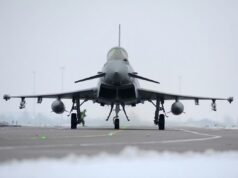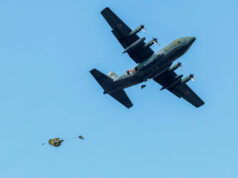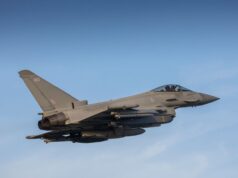The Ministry of Defence has a requirement for a man portable capability to “Defeat” autonomous, small (NATO Class 1) Unmanned (Fixed Wing and Rotary Wing) Aircraft Systems (sUAS) by a kinetic effect “Hard Kill” solution which is not reliant on RF jamming technology.
• Identify what capabilities Industry has to meet the requirements in the immediate future, for delivery within 2022;
• Identify what Industry is developing to meet the requirements in the near future, for delivery within 2023.
• Identify technologies with the development potential to evolve to meet emerging threats, beyond 2023.
The event will comprise of two stages, detailed as follows:
“Stage 1: Presentation Companies will deliver a 30-minute presentation of their product via virtual conferencing (e.g. Microsoft Teams), covering functionality, feasibility, technological robustness, deliverability, and development potential. This will allow companies with either Commercial Off The Shelf (COTS) products or products in development to present their solutions.
Stage 2: Demonstration Companies who have presented a product suitably safe and sufficiently developed to be operated on a Trials Range will be invited to demonstrate their capability within a 1-hour timeslot in a live environment.”
The demonstration will entail each product supplier operating their C-UAS system to engage a Class 1 target UAS approaching from a distance of 500m.
“The target set will take the following format, with the effectiveness being determined upon the incremental reduction in target difficulty. If the target is defeated on scenario 1 or 2, scenario 3 will not be performed.
Scenario 1: 500m to 100m, evading manoeuvres to target.
Scenario 2: 500m to 100m, direct line to target.
Scenario 3: 100m to 20m staged approach, left-right traverse, then stationary at each 20m increment, tenderers will be given 1 opportunity at each stage to defeat the drone.”
The location of the industry event is still to be determined, however this will likely to be on Salisbury Plain Training Area.
“Event Target Target drones falling under NATO Class 1 mini (<15kg) classification will be utilised. Event Administration and manning Industry participants will be self-sufficient during the event. Specific arrangements will be announced once the level of response has been determined. It is anticipated the Industry Event will be held over several days with companies only required to attend on one day.”
Timeline for this project.
1) Deadline for registering interest for the Industry Day – 24-09-2021
2) Industry Engagement via MS Teams – WC 27-09-2021
3) Industry Demonstration – Live – WC 18-10-2021
4) DPQQ Publication – Estimated October 2021
5) Tender Publication – Estimated December 2021
6) Contract Award Date – Feb 2022
Back in 2019, the Defence and Security Accelerator (DASA) announced that it has awarded nearly £2 million in contracts to develop new capabilities to detect, disrupt, and defeat the hostile and malicious use of drones.
David Lugton, competition technical lead, said:
“The introduction of Unmanned Air Systems (UAS), often referred to as drones, has been one of the most significant technological advances of recent years and represents a shift in capability of potential adversaries.
The threat from UAS has evolved rapidly and we are seeing the use of hostile improvised UAS threats in overseas theatres of operation. There is a similar problem in the UK with the malicious or accidental use of drones becoming a security challenge at events, affecting critical infrastructure and public establishments; including prisons and major UK airports.”
Eighteen bids have been funded as part of the Countering Drones competition launched earlier this year by the then-Defence Secretary. You can read more here.
https://ukdefencejournal.org.uk/contracts-awarded-to-counter-hostile-drone-threats/














Essential area of defence where we cannot keep kicking the can down the road. We needs to ensure we have adequate and sufficent Anti-UAV assets, both kinetic and none kinetic, for all types and classes of possible UAVs we may come across in the future.
Airborne wrote:
An apt metaphor , which sums up the procurement policy at the MOD to a tee.
Quite adept the MOD have probably been watching YouTube and seeing how versatile these rotary Drones can be ISIS saw their ability to not only survey but deliver orderance 2015-18
Let’s hope this procurement process doesn’t get screwed up by the MoD.
Cue cynical laughter from everyone ☝
:wpds_mrgreen:
It would have helped if the article above had included this chart:
What we need is a big fricken laser!
Seriously though, the MoD are about 5 to 7 years behind the drag curve! The Ukrainian border conflict, was the first to use commercially bought (toy) quadcopter drones for attacking troops, after proving they were useful for surveillance. A simple servo operated mechanism that dropped a grenade into a trench was the first development, quickly followed by mortar shells carried by larger drones dropped onto vehicles.
This development was then seen in Syria and lately in Libya. Who needs a mortar when you can literally pick your target and get a 100% hit by using a drone.
Ukraine have developed a number of countermeasures. Ranging from shotguns to modified Shilka SPAAGs. They have also developed specific electronic counter measures to jam the drones control and video signals.
The problem is detection. It is very hard to visually locate a drone, let alone hear one that is more than 50m away when it’s hovering against wood or a building backdrop. Therefore you’ll need a form of active searching. You need to detect the drone at a safe enough distance, where it can’t “see” you. The heat generated by the drones motors and battery will be minuscule and only be detectable fairly close. So you need either a radar or lidar.
If we are talking about the small pocket sized class 1 drones like the Black Hornet. These are going to next to impossible to detect, unless you use a very high frequency radar operating in the V (40 to 75GHz) or W-bands (75 to 100GHz). At these frequencies the wavelength is measured in mm, so there’s a much greater chance that the beam will get a hit and return.
Following on from this would be lidar. It uses wavelengths in the nm scale. So would have a even better chance. The issue with lidar is that they generally use a mechanically steered mirror to steer the beam. These aren’t really robust enough to stand up to the abuse of field conditions. Although there have been recent developments with electronically phase steering a laser beam, which will help massively. Lidar is peculiar in that you would believe it would be massively affected by rain etc. But this isn’t the case. Because the wavelength is so small and the sweep speed so fast, it will literally map a sector which is frozen in time. Therefore the rain drops are mapped, but so is everything else around and behind it. This is constantly updated so you can use a moving target algorithm to track other moving targets like a slow moving drone that’s flying parallel to the ground and not falling.
Therefore, currently the best method to use for detecting these very small drones would be an AESA radar operating in the V or W band. The radar will be pretty small as the antenna size is about the size of a credit card or smaller. It’s range won’t be fantastic, possibly up to 5km using top end components with high power ratings, more likely 1km for “more robust” components. But the whole package, including the antenna assembly, ECU, display and battery pack could be the size of a 5.56mm ammo can, mounted on a camera tripod.
The next issue would be how to disable or kill the drone? Commercially available drones uses 2 frequencies, one for control and one for video feedback. These frequencies are governed and are centred around 2.4 and 5.8GHz. Therefore, they would be pretty easy to jam with a highly directional transmitter operating at these frequencies. Military drones are a different problem, as they may use different frequencies and randomly hop them, to counter the jamming. Which would then require a hard kill countermeasure.
You could quite easily rig up a remotely operated weapon station (RWS) to the anti-drone radar. A GPMG or 50 cal could be used, their accuracy is adequate enough to score at least one hit out of 10 rounds fired at targets around 500m away for something like a Black Hornet even further for a larger quadcopter. But you will be wasting a lot of ammo if it is moving and not hovering. Plus, there’s the issue of where these rounds will be going. A small quadcopter won’t stop the round!
I have discounted lasers, as these will need to be vehicle mounted, but also be powered by a genset for a high power output, so therefore noisy.
We have used proximity fused shells against aircraft since WW2. They work by actively transmitting either a radar signal or laser beam. If the shell detects a return signal it activates the fragmentary explosive. Where the blast wave and shell’s shrapnel damage the target, hopefully catastrophically. The problem here is that there is a minimum size for the electronics to fit into, which can be as small as a 25mm shell. But then it won’t carry enough explosive to cause enough damage. A 30mm is ok, but a 40mm is better. The larger the shell the larger the explosive content.
A 40mm auto-cannon is not a small piece of kit. We are talking something like a Bofors anti aircraft gun. The cartridges are around 400mm long. So the whole thing needs to mounted on a vehicle or trailer, not ideal for mobility or a small section. Plus the Bofors has an effective range of over 5km, a bit overkill for a target that’s only 100m away. Plus, the shell will definitely keep going if it misses the target. Though it may have a max range timer. If the Warrior program does get resurrected or AJAX’s problems are fixed, its possible that they may get an active protection system. A system like Trophy uses an X band radar, which will be ok at detecting largish drones, but not the really small ones. However, the CTA40 could be linked to the Trophy’s ECU as per the Merkava. The CTA40 has an anti-air round that could be used against small drones. Though I believe its a programmable shell not a proximity fused one?
Therefore, a weapon is needed that can be used against very close targets as well as those around 500m away. That uses proximity fusing to minimize shots fired and to have a greater chance of scoring a hit. How about the 40mm grenade fired from GMG?
These come in 3 flavours within NATO classification, a low, medium and high velocity. The version is dependent upon what they are fired from. The low velocity is fired from under-barrel launchers like the M203. The medium is a bit like an extended range version of the low velocity one and is also used in handheld weapons. the high velocity one is for use in mounted weapons like our HK L134A1 GMG. The higher velocity round helps generate the necessary force required for the weapon’s blow back recoil system. Don’t fire these from an under-barrel launcher, it will hurt!
A radar controlled RWS using a GMG mounted on a Jackal, Cayote, Foxhound etc is doable and would also have the dual role of enemy suppression. But importantly be capable of dealing with Class 1 and higher drones. The 40x53mm grenade has the available volume where a proximity fuse could be fitted, but still contain enough explosive to damage/destroy a drone.
For a foot section, it becomes a major problem. The HK weighs in close to 40kg when including a tripod. This is too much for a 8 man patrol, that will also be lugging a GPMG plus its ammo, NLAW, radios etc, doubly so if the 60mm mortar returns. The underslung grenade launcher firing the medium velocity grenades may be of use. But the team will need to be carrying and setting up the radar. Then have a means of linking the radar and operator to the grenade launcher, to make sure they point and range the target properly. I can’t really see that working to well, especially if you need to be highly mobile. Perhaps it would be better to have a two section team set up for overwatch, allowing the mobile team freedom to operate unburdened?
Some of this I was aware of (mainly the last few paragraphs ;0) some of this not, great informative post Davey as normal.
You should ask George for a job. Not joking that’s the best description of UAV anti UAV i’ve ever read. ☝
Seems to be a lot of movement towards drone killing drones, the Russians are bigging up their latest examples effectiveness against their Turkish competitors if belatedly considering their humiliation in the recent Nagorno Karabakh conflict. Judging by your contribution it seems like there is going to be a need for wide ranging solutions from basic hand held to more complex, multi layered and flexible vehicle mounted solutions to deal with the various size and complexity of threats. Even then it’s going to be a long hard learning curve I suspect much through real time trial and error. Sounds reminiscent of 1st and 2nd WW developments that existing or quickly designed counter measures had varying levels of success/failure against and where often those designed for other purposes became very useful.
I agree. What works for a divisional HQ would be useless for a 8 man section out on patrol. Though the concept of detection is likely to be the same.
In recent news, India are rapidly purchasing a number of systems that can be used to project dockyards, airfields and logistical infrastructure. These all seem to be mounted on a large 4 x 4 MRAP type vehicle. They are combining both a soft kill, i.e. communications jamming with a hard kill high powered laser system. They haven’t published any details on how the Navy or Army systems detect and then track the drones. Though the system the Indian Airforce is getting from Zen Technologies, uses a 3D X-band radar.
Out of interest just coincidentally came across this article. https://news.usni.org/2021/09/07/navy-arming-surface-ships-with-drone-repellent-system
Another interesting article
https://www.popularmechanics.com/military/weapons/a37320840/laser-guns-on-stryker-armored-vehicles/